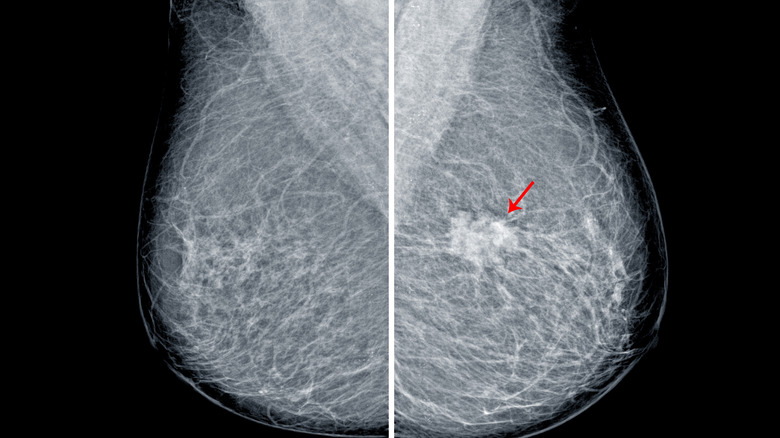Are Breast Calcifications Cause For Concern?
Mammograms provide physicians with an X-ray image of a patient's breast in order to check for abnormalities that may indicate the potential for breast cancer, reports the U.S. Centers for Disease Control and Prevention (CDC).
In addition to masses, distortions, and asymmetries, breast calcifications can also be picked up by mammogram technology, according to the American Cancer Society. Usually showing up on X-rays in the form of white spots, breast calcifications are calcium deposits located within the breast tissue (per BreastCancer.org). They often signify changes occurring in the breast tissue, and are frequently found in people postmenopause.
According to experts at the Cleveland Clinic, breast calcifications can take two forms. Macrocalcifications appear as large, white spots dispersed throughout the breast. Microcalcifications, on the other hand, usually pop up as small, white dots. Like macrocalcifications, they may appear scattered, but they can also show up in clusters or in the shape of a line.
Awaiting the results of a mammogram can bring on feelings of anxiety for patients. Therefore, it can be helpful to know ahead of time whether or not breast calcifications are cause for concern in the event that your doctor finds them present in your X-ray images.
Breast calcifications and cardiovascular risk
Experts at the Cleveland Clinic explain that roughly 50% of individuals assigned female at birth develop breast calcifications that are noncancerous. Most frequently, they are macrocalcifications and usually do not require further testing.
Similarly, microcalcifications are also generally noncancerous. However, in some cases, microcalcifications can be indicative of breast cancer and your physician may opt for follow-up testing to check for the presence of cancer cells.
BreastCancer.org explains that breast calcifications themselves do not progress into cancer. While breast calcifications are not usually associated with breast cancer, some studies suggest there may be a relationship between breast arterial calcifications and cardiovascular risk, reports the American Heart Association (AHA). As defined by the AHA, "Breast arterial calcification is calcium build-up within the middle layer of the breast's arterial wall."
According to a 2020 scientific review published in PLOS One, breast arterial calcifications are found on anywhere from 3% to 29% of mammograms. Furthermore, a number of the studies the researchers examined found a link between breast arterial calcifications and hypertension. Additionally, moderate to severe cases of breast arterial calcification were associated with higher risk for coronary artery disease.
Researchers from an alternate 2022 study published in Circulation: Cardiovascular Imaging found similar results to the 2020 analysis. In their research paper, the study team suggests that breast arterial calcifications should be considered a potential risk-enhancing factor for heart disease.


